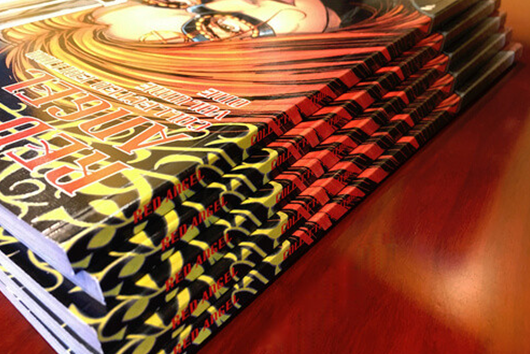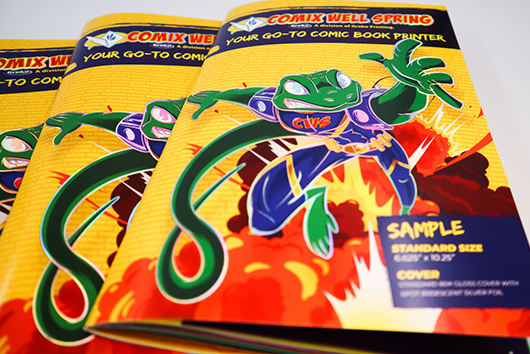What Is the Difference Between a Graphic Novel and a Comic Book?
October 20, 2023
Graphic novels and comic books whisk us away to worlds of heroism and fantasy with the turn of each page. At first glance, they may seem identical—both are rich with vibrant art and compelling narratives. However, going deeper, you’ll find that each has unique storytelling language and cultural significance.
Whether you’re a seasoned enthusiast or a curious newcomer, understanding the difference between a graphic novel and a comic book helps you appreciate them better. It also equips you to create your own stories in these formats.
History and Evolution of Comic Books
Comic books as we know them began in the 1930s. But the idea of using pictures to tell stories? It’s been around for ages, from Egyptian hieroglyphs to medieval tapestries. The real game-changer was the rise of printing, which lets stories be told in regular comic strips in newspapers. From there, it wasn’t a big leap to the comic books we love today.
The evolution of comic books demonstrates their adaptability and resilience. The Golden Age of Comics, which started in 1938 with the release of Action Comics #1, witnessed the emergence of other superhero icons like Batman, Superman, Captain America, and Wonder Woman. This reflected society’s need for hope and escapism during the challenging times of the Great Depression and World War II. These characters not only brought a boom to the industry but also became cultural phenomena.
The Silver Age brought characters to life with deeper stories and emotions, probably because the fans were growing up too. Then, in the Bronze Age of the 1970s and 1980s, comics began addressing issues like racism, substance abuse, and the environment. It wasn’t just about superheroes anymore; it was about the real world.
In the Modern Age, comic books have stepped into the spotlight, being recognized as legitimate literature and art forms. Our favorite superheroes are leaping off the pages and onto the big screen, taking over the movie world and racking up rave reviews, showing how comic books continue to shape our culture and capture our imaginations.
History and Evolution of Graphic Novels
In the 1960s and 1970s, writers and artists wanted to tell deeper, longer stories than regular comic books allowed. That’s when the idea of the graphic novel began to blossom.
However, the term “graphic novel” really took off after Will Eisner’s A Contract with God in 1978. These weren’t just regular comics – they were longer, more in-depth, and you could find them in bookstores. Perfect for a more grown-up crowd, this format allowed writers to explore more complex narratives, character development, and in-depth themes.
The 1980s and 1990s saw a surge in the popularity of graphic novels, with seminal works like Art Spiegelman’s Maus — which won a Pulitzer Prize — and Alan Moore’s Watchmen — featured on Time’s list of the 100 best novels. These successes made it clear that graphic novels weren’t just a passing trend. They stood toe-to-toe with traditional novels, delivering powerful stories that could tug at your heartstrings just as much.
Now, in the 21st century, graphic novels are only getting bigger and better, branching out into various genres and grabbing the attention of more readers. They’ve made a solid spot for themselves in the literary scene, and plenty have even hit the big screen or been turned into TV shows.
Graphic novels have also become an essential part of educational programs. They are ideal for encouraging reluctant readers and presenting challenging topics in an easy-to-understand way.
Characteristics of Comic Books
Comic books aren’t just for kids. These texts feature complex stories, ideas, and themes brought to life through a unique blend of visual techniques. Some of the characteristics that help comic books tell their story and engage their readers include:
- Dynamic artwork: Comic books use vivid, dynamic artwork to help the story leap off the page. Artists use a range of styles, from hyperrealistic drawings to cartoonish characters, to create panels that convey motion and intense emotions.
- Panel progression: The layout of panels in a comic book guides the reader’s eye across the page, dictating the pace and timing of the story. This sequencing is crucial to storytelling, creating rhythm and emphasizing key moments.
- Color schemes: Colors in comic books are not just for aesthetic appeal; they also carry meaning and tone. Using bold, primary colors often signifies heroes and action, while darker hues can suggest a more serious or ominous atmosphere.
- Textual elements: Dialogue balloons, sound effects, and narrative captions are textual elements unique to comics. These sound bytes blend with the images to tell the story by providing context and insight into what the characters are thinking and feeling.
- Various genres: Comic books cover all sorts of stories – from superhero and science fiction to horror, fantasy, romance, and even historical dramas. They show the wide range of what we can imagine and experience.
- Character development: As comic book characters have developed over the years, they’ve become more complex, with personalities that have many sides to them. They come with rich backstories and reasons for what they do, and they change and grow in ways that can be just as deep as the characters you find in novels.
- Moral and ethical questions: Comic books frequently explore difficult questions about right and wrong and what it means to do the right thing. They get into issues like who we are, what we should be responsible for, and the idea of fairness. Especially with superhero comics, which often look at what being a hero is about in an imperfect world.
- Cultural reflection: Comic books tend to capture the vibe and issues of the times they were created. They can show society’s concerns, what it hopes for, and the general mood of the era.
- Mythology and archetypes: Many comic books draw on ancient myths like the Quest or the Creation Myth and universal archetypes like the Chosen One or the Trickster, reinterpreting age-old tales in modern settings. They resonate with readers by tapping into stories of epic adventures and legendary heroes.

Characteristics of Graphic Novels
Graphic novels have become a celebrated form of literature for their combination of engaging narratives and amazing artwork. They go beyond what you’d find in regular comic books, giving readers a cinematic experience on paper. The way they blend words and pictures, graphic novels can tell deep, emotional stories that are just as good as any novel.
Some defining characteristics of graphic novels include:
- Sophisticated visuals: Graphic novels usually pack in more artistic detail than your average comic book. They’ve got more room to play with, so artists can go into more detail on the backdrops, give characters lots of subtle touches, and create a visual story that feels full and rich.
- Stylistic diversity: Graphic novels use all kinds of art styles, from simple black-and-white drawings to vibrant, colorful scenes. Each style sets a different mood and adds to the story’s vibe.
- Layout and design: The page layout in graphic novels is carefully designed to control the reader’s experience of the story. Unlike traditional comics, which usually feature rigid grids, graphic novels use unconventional panel shapes and page designs to increase the dramatic effect.
- Integration of text and art: In graphic novels, the words often blend right into the pictures, sometimes even becoming part of the artwork itself. This mix adds extra depth to the story.
- Complex storytelling: Graphic novels typically have elaborate and well-structured plots. They can delve into character backstories, plot twists, and detailed worlds, thanks to their lengthier format.
- Mature themes: Many graphic novels target adult audiences and tackle mature themes such as philosophy, politics, and personal crises. This format shows that visual storytelling isn’t only for children or young readers.
- Cultural commentary: Graphic novels have become a medium for social and cultural commentary. They can provide insights into contemporary issues like immigration, war, and identity.
- Literary allusions: It’s not uncommon for graphic novels to contain references to or reimaginings of classic literature. They also integrate elements from well-known stories to create something entirely new and relevant for today’s readers.
- Emotional depth: With space to explore and develop complicated emotions, graphic novels often create a deep connection with the reader through relatable characters and situations.
The Primary Differences Between Graphic Novels and Comic Books
Graphic novels are essentially a subsection of the comic book genre; however, they extend beyond what comic books convey to become literary masterpieces in their own right. This means that while graphic novels and comics may have numerous similarities, several differences distinguish each text type:
Length and Format
Typically, comic books are serialized publications, with stories told across multiple issues. They are usually around 32 pages long, often ending with a cliffhanger that leads into the next installment.
Graphic novels are generally longer, complete stories presented in a single volume. They range from around 48 pages to several hundred, providing a more in-depth storytelling experience similar to a novel.
Storytelling and Artwork
Comic books offer episodic fragments of larger stories, encouraging readers to return for each new installment. Whereas graphic novels feature a self-contained story with a distinct beginning, middle, and end.
Thanks to their longer format, graphic novels give artists extra room to create detailed backgrounds and really show off characters’ emotions. So, often, you’ll find richer visuals in graphic novels compared to the more straightforward art in regular comics.
Publication and Production
Comic books are usually published regularly, often monthly or bi-monthly, and are designed to maintain long-running stories. Some of those comics from the Golden and Silver Ages? They’re still a hit, carrying on tales that started decades ago.
Graphic novels usually standalone, though some come as a part of a series or multiple volumes. They don’t really follow a strict release schedule, being published maybe every six months to a year. This is due to the work required to produce and publish a graphic novel than a comic.
Production methods also differ between the two media. Comic books are traditionally printed on thinner paper and are bound with staples. However, several comic issues in a series may also be collected and bound as an omnibus. This is usually produced on thicker paper with a stronger binding.
Graphic novels are produced with higher-quality paper, often with durable square binding like traditional books, making them more durable for frequent handling and shelf display.

Create Your Comic Book or Graphic Novel
Understanding the differences between a graphic novel and a comic book can help you decide which medium is suitable for telling your story. Whether you’re an artist looking to serialize a dynamic superhero saga or a writer aiming to weave an intricate narrative into a standalone book, choosing the proper format is vital to your tale’s impact and appeal to readers.
At Comix Well Spring, we can help bring your vision to life with our premium printing services. With our state-of-the-art printing technology, your artwork and stories will leap off the page in vibrant color and crisp detail.
We offer various binding options, from classic saddle stitch formats for comic books to square binding for graphic novels, ensuring a professional look and feel. You can customize the size, paper type, and finish to match the tone and style of your work, and we also offer options like foil covers to help your comic stand out.
When you print with Comix Well Spring, you’re not just getting a product; you’re creating an experience for your audience. Explore our services at Comix Well Spring today to bring your comic book or graphic novel to life and into the hands of eager readers everywhere.

